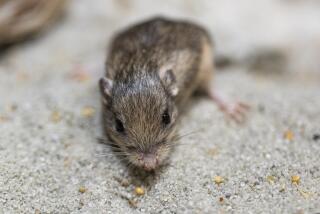How Unique the Mouse? A Study Creates a Furor
- Share via
DENVER — Biologist Rob Roy Ramey figures that he has risked his life many times for endangered species -- scaling cliffs to help with peregrine falcons and California condors, challenging sheep poachers in Mongolia, being chased by elephants in Africa.
His toughest encounter, though, could be with a mouse thought to exist only in a narrow corridor along the east face of the Rockies. His conclusion that the Preble’s meadow jumping mouse isn’t unique has made it the poster animal for critics of the Endangered Species Act and outraged fellow scientists and environmentalists who accuse him of faulty science.
The study by Ramey and his colleagues says the Preble’s mouse is the same as the more common Bear Lodge meadow jumping mouse and shouldn’t be listed as a threatened subspecies. The U.S. Fish and Wildlife Service agreed and has started the process to drop the mouse from the endangered species list. A final determination is expected next year.
The decision comes as members of Congress and others say the law has failed to help most threatened and endangered animals and should be rewritten.
“It’s a great example of what’s wrong with the Endangered Species Act,” Denver attorney Kent Holsinger said of the 1998 decision to protect the mouse. “We’re spending more money on a species that doesn’t exist than on the humpback whale.”
Holsinger represents Coloradans for Water Conservation and Development, a group of landowners, farmers and businesses that, along with the state of Wyoming, petitioned in 2003 to delist the mouse. He said millions of dollars have been spent protecting mouse habitat from southeast Wyoming to Colorado Springs in Colorado. A Denver area water and sanitation district even added mouse tunnels and bridges to a project.
The tiny mouse that can jump more than a foot in the air isn’t going away quietly. Fish and Wildlife is considering taking more public comment.
The American Society of Mammalogists wrote to federal officials in April, assailing Ramey’s work as “inconclusive at best, and methodologically flawed at worst.”
Ramey, chairman of the zoology department at the Denver Museum of Nature and Science, stands by his work. He believes that some of the wrath stems from his upending a 1954 study that declared the Preble’s meadow mouse a subspecies.
“My research and paper came as a challenge to the traditional approach,” he said.
He has also been accused of crossing the line from science to advocacy for testifying before Congress last year about the need to revamp the Endangered Species Act.
What riled the mammalogists was Ramey’s research methods, said Roland Kays, curator of mammals at the New York State Museum.
“Being a maverick can be admirable, but quite often those people are just wrong. There’s a reason that traditional science is not a bad thing,” Kays said.
Ramey said he and his team initiated the study, which was also funded by Fish and Wildlife and the Denver museum. Fish and Wildlife said eight of the 14 original peer reviews of the study agreed that the mouse wasn’t a distinct subspecies.
“Based on what data they gave us, it looks fairly clear cut,” said Robert Bradley, an associate professor of biology at Texas Tech University who agrees with Ramey’s findings.
Critics contend that some of the more positive reviews still questioned the methodology and said the mouse should be protected because of shrinking habitat. Biologist Dave Hafner originally sided with Ramey but said he changed his mind.
Because Ramey appears to be viewing the Preble’s mouse as a species rather than a subspecies, he mistakenly concluded that genetic similarities with the Bear Lodge mouse mean that the two were the same, Hafner said. The team should have focused on differences between the mice because those support recognizing the Preble’s mouse as a subspecies, he said.
Ramey said the latest study expanded the genetic testing -- and that still supports his conclusion.
More to Read
Sign up for Essential California
The most important California stories and recommendations in your inbox every morning.
You may occasionally receive promotional content from the Los Angeles Times.












